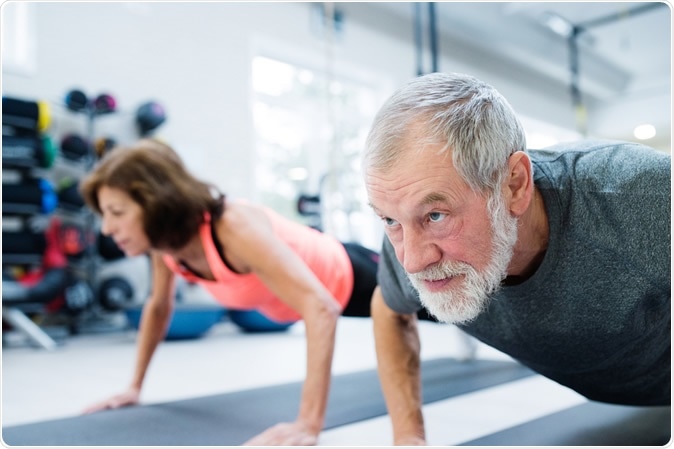A bold new study suggests that muscle strength in older adults may be higher due to, in part, mechanisms involving gut bacteria.
The gut bacteria are related to muscle mass and physical function, in a relationship called the gut-muscle axis, which has been studied in mouse models and in young adults. A new study looks at the GMA in older adults for the first time.

Image Credit: Halfpoint / Shutterstock
In mice, the transfer of bacteria from the cecum of healthy mice into germ-free (GF) mice causes a reduction in lean mass. The same observation has been made after antibiotic treatment in mice. On the other hand, the administration of prebiotics or probiotics leads to increased gut bacteria and also increased muscle mass, as several earlier experiments have shown. The gut bacteria showed increases in the families Prevotellaceae and Barnesiella. The latter was also shown to be lower in older rats corresponding to the age-related loss of lean body mass.
In older and frailer adults, too, gut diversity has been observed to change in accordance with changes in lean mass. However, physical function has not been directly assessed in relation to gut bacterial changes in older adults so far. The current study aimed at finding which bacteria are directly related to increased lean mass and physical functioning in older adults. Secondly, these findings were validated by transferring the gut microbiome samples into GF mice so that the human gut microbiome could be replicated, while observing the effect on lean mass and physical function.
How was the study done?
The gut microbiome composition in 18 older adults aged 70-85 years, who were functioning at a high level, and had a healthy body build, with low fat and high lean fat, was compared with that in 11 sedentary older adults of the same age group but with poor function and a less healthy body composition. Sedentary adults were identified as those who had no structured physical exercise for six consecutive months or more, prior to the start of the study. All had a BMI of 35 or less.
The body composition was measured using dual-energy X-ray absorptiometry (DXA) scanning, using measures of lean mass, fat mass and bone mineral content. Physical function was assessed in terms of lower extremity function, mobility, and strength using the short physical performance battery (SPPB) score, first at baseline and then at one month. This score uses standing balance, a 4-m walk, and a chair stand test. A cut-off of 8 and 11 was taken for low physical function (LF) and high physical function (HF) respectively.
In the next step, fecal samples from the two groups were transplanted into the guts of young GF mice of corresponding gender. Each sample was gavaged into five GF mice. The body composition in mice was evaluated by quantitative magnetic resonance imaging (MRI), while physical function was assessed by grip strength and treadmill endurance capacity. The measurements were taken both at baseline and after one month of fecal transplantation in both groups.
What were the results?
In the HF group, the gut bacterial profiles showed a significant increase in Prevotellaceae at family level, followed by genus-level increases in Barnesiella and Prevotella. The species Barnesiella intestihominis was also found to be higher. These differences persisted at one month, while other differences were unstable between the study visit and the one month follow-up.
The mice developed the same differences in bacterial composition, but also showed an increase in muscle strength when the samples they received were from the high-functioning adults. This suggested the link between muscle strength and the gut microbiota, though neither endurance capacity nor body composition showed any significant changes. This must be qualified by the fact that the study took place over a short period.
What do we learn?
Prevotella has been seen to be higher in young athletes and in stronger older adults, in earlier studies. This seems to corroborate the link between these bacteria and muscle mass maintenance. There was no significant difference between the diet of HF and LF older adults, which does not support the effect of diet on these bacteria. Both Barnesiella and Prevotella do produce short-chain fatty acids (SCFAs) like acetate and propionate that could be instrumental in improving muscle strength.
The study authors expected to see the effects of the change in gut bacteria reflected in the body composition, which didn’t happen. The timing of the muscle strength measurement may also not have been optimal to detect the greatest increase, in comparison with other studies. However, the study does indicate that gut bacteria play a role in muscle strength, and this type of change should be foreseen with future interventions. Researcher Michael Lustgarten says, “If we were to conduct an intervention to increase Prevotella levels in the gut microbiome, we would expect to see an increase in muscle strength if these bacteria are involved. Prevotella's role in the maintenance of muscle strength in older adults is one area we expect to continue to explore.”
The study was published online in the journal Experimental Gerontology on September 4, 2019.
Journal reference:
Muscle strength is increased in mice that are colonized with microbiota from high-functioning older adults. Roger A. Fielding, Andrew R. Reeves, Ravi Jasuja, Christine Liu, Brittany B. Barrett, & Michael S. Lustgarten. Experimental Gerontology 127 (2019)110722. https://doi.org/10.1016/j.exger.2019.110722. https://www.sciencedirect.com/science/article/pii/S0531556519304772?via%3Dihub